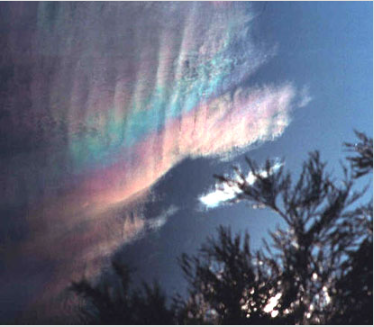Iridescent Clouds - Banded iridescence
Iridescent Clouds - Exploring the Enigmatic Beauty of Banded Iridescence
Have you ever looked up at the sky and witnessed a breathtaking display of colors dancing within the clouds? These mesmerizing phenomena, known as iridescent clouds, never fail to captivate our imagination. One particular type of iridescence that deserves our attention is banded iridescence. In this article, we will delve into the intriguing world of banded iridescence, exploring its formation, characteristics, and the scientific principles behind its stunning appearance.
The Birth of Banded Iridescence
Banded iridescence occurs when sunlight interacts with tiny water droplets or ice crystals within a cloud. Unlike other forms of iridescence, banded iridescence displays a distinct pattern of parallel bands or stripes of vibrant colors. These bands can range from a few millimeters to several centimeters in width and often extend across large portions of the cloud.
The Secrets of Uniformity
One fascinating aspect of banded iridescence is its remarkable uniformity. Unlike other types of cloud iridescence that exhibit a more random distribution of colors, banded iridescence showcases a consistent color pattern across the cloud. This uniformity arises from the freshly formed nature of the cloud and the resulting uniformity in the sizes of the water droplets or ice crystals within it.
The Science Behind the Spectacle
To understand why banded iridescence occurs, we must delve into the scientific principles of light diffraction and interference. When sunlight encounters the tiny droplets or crystals in the cloud, it undergoes diffraction, causing the light waves to bend and scatter. As these waves interact with each other and with the droplets or crystals, they interfere constructively or destructively, creating the vibrant bands of color that we observe.
Unveiling the Colors
The colors exhibited in banded iridescence are a result of the interference and diffraction of light. The size of the droplets or crystals within the cloud determines which colors are most prominently displayed. Smaller droplets or crystals tend to scatter shorter wavelengths of light, such as blue and violet, while larger ones scatter longer wavelengths, such as red and orange. Consequently, the bands of color we see in banded iridescence can range from cool blues and purples to warm oranges and reds.
Environmental Factors at Play
Several environmental factors can influence the formation and appearance of banded iridescence. The presence of uniform-sized droplets or crystals is crucial for the formation of well-defined bands. Additionally, the angle at which sunlight interacts with the cloud, as well as the viewer's position relative to the cloud, can affect the visibility and intensity of the iridescence. The presence of other atmospheric phenomena, such as high-altitude clouds or pollution particles, can also contribute to the complexity and beauty of banded iridescence.
Captivating the Human Imagination
The ethereal beauty of banded iridescence has long captivated the human imagination. Throughout history, these mesmerizing displays have been interpreted as signs of good fortune, spiritual messages, or even portals to other dimensions. Artists and poets have sought to capture the essence of banded iridescence in their works, attempting to convey its enchanting allure to those who have yet to witness it firsthand.
The Quest for Knowledge Continues
While we have made significant strides in understanding banded iridescence, there is still much to learn about this enigmatic atmospheric phenomenon. Scientists continue to study the intricate interplay between light and water droplets or ice crystals within clouds, striving to unravel the mysteries behind the formation and characteristics of banded iridescence. Through their research, we inch closer to comprehending the full extent of nature's artistic prowess and the marvels that unfold above our heads.
A Reminder of Nature's Grandeur
Banded iridescence serves as a reminder of the awe-inspiring beauty that exists within our natural world. It encourages us to look up from our busy lives and appreciate the wonders that surround us. So, the next time you find yourself gazing at the sky, keep an eye out for the mesmerizing bands of color that may grace the clouds above. It is in these fleeting moments of ethereal enchantment that we can find solace, wonder, and a deeper connection to the magnificent tapestry of the universe.

Banded iridescence.
Imaged by Ray Rochelle on a cold morning in Northern California, November 2001.
This cloud is freshly formed, accounting for the large-scale uniformity of its droplet sizes and hence its colours.
Photo ©Ray Rochelle, shown with permission
Note: this article has been automatically converted from the old site and may not appear as intended. You can find the original article here.
Reference Atmospheric Optics
If you use any of the definitions, information, or data presented on Atmospheric Optics, please copy the link or reference below to properly credit us as the reference source. Thank you!
-
<a href="https://atoptics.co.uk/blog/iridescent-clouds-banded-iridescence/">Iridescent Clouds - Banded iridescence</a>
-
"Iridescent Clouds - Banded iridescence". Atmospheric Optics. Accessed on April 19, 2024. https://atoptics.co.uk/blog/iridescent-clouds-banded-iridescence/.
-
"Iridescent Clouds - Banded iridescence". Atmospheric Optics, https://atoptics.co.uk/blog/iridescent-clouds-banded-iridescence/. Accessed 19 April, 2024
-
Iridescent Clouds - Banded iridescence. Atmospheric Optics. Retrieved from https://atoptics.co.uk/blog/iridescent-clouds-banded-iridescence/.